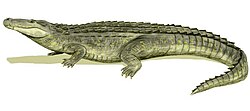Phylogeny
Cladistically, Alligatoroidea is defined as Alligator mississippiensis (the American alligator) and all crocodylians more closely related to A. mississippiensis than to either Crocodylus niloticus (the Nile crocodile) or Gavialis gangeticus (the gharial). [8] This is a stem-based definition for alligators, [9] and is more inclusive than the crown group Alligatoridae. [10] As a crown group, Alligatoridae only includes the last common ancestor of all extant (living) alligators, caimans, and their descendants (living or extinct), whereas Alligatoroidea, as a stem group, also includes more basal extinct alligator ancestors that are more closely related to living alligators than to crocodiles or gavialids. When considering only living taxa (neontology), this makes Alligatoroidea and Alligatoridae synonymous, and only Alligatoridae is used. Thus, Alligatoroidea is only used in the context of paleontology.
Traditionally, crocodiles and alligators were considered more closely related and grouped together in the clade Brevirostres, to the exclusion of the gharials. This classification was based on morphological studies primarily focused on analyzing skeletal traits of living and extinct fossil species. [11] However, recent molecular studies using DNA sequencing have rejected Brevirostres upon finding the crocodiles and gavialids to be more closely related than the alligators. [12] [13] [14] [10] [15] The new clade Longirostres was named by Harshman et al. in 2003. [12]
A 2018 tip dating study by Lee & Yates simultaneously using morphological, molecular (DNA sequencing), and stratigraphic (fossil age) data established the inter-relationships within Crocodilia, [10] which was expanded upon in 2021 by Hekkala et al. using paleogenomics by extracting DNA from the extinct Voay . [15]
The below cladogram shows the results of the latest study:
This page is based on this
Wikipedia article Text is available under the
CC BY-SA 4.0 license; additional terms may apply.
Images, videos and audio are available under their respective licenses.






